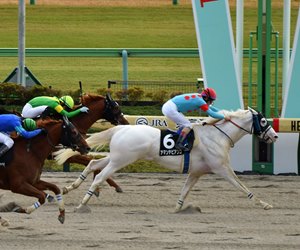White Colt Amante Bianco Wins Cattleya on 'Japan Road'


Can a white horse win the Kentucky Derby?
"Possible," said jockey Christophe Lemaire after alighting from Amante Bianco, the pure white winner of the Cattleya Stakes Nov. 15 at Tokyo Racecourse.
The possibility is one early, tentative step closer to reality as the Cattleya is the first race in the "Japan Road to the Kentucky Derby"—a series that awards the overall top points-earner a guaranteed spot in the Run for the Roses.
The Derby has seen eight gray or roan winners, including the filly Winning Colors in 1988. There have been four winners officially designated as black. But pure white horses, a rarity in the overall equine population, await their first turn in the Churchill Downs infield winner's circle.
Amante Bianco, a Henny Hughes colt bred by the omnipresent Northern Farm, doesn't need much more on his resume to get a chance to break that barrier in the Derby's 150th running next May 4.
Out of the Kurofune mare Yukichan , the colt won at first asking, going 1,400 meters (about 7 furlongs) on the dirt at Tokyo Racecourse June 17. He followed that with a third-place finish in the Oct. 14 Platanus Sho, also at Tokyo but at 1,600 meters (about 1 mile). In that race, he was near the rear of the field turning into the uphill stretch run, made up substantial ground and flattened out through the final 200 meters.
In the Cattleya, Lemaire kept him near the middle of the 16-horse field and the colt closed with determination, readily passing rivals through the same 200 meters to get home first by three-quarters of a length while finishing in 1:37.5.
George Tessoro, was second, followed by Godolphin homebred Unquenchable, Star Turn and More Than Once, a Majestic Warrior filly who led through the early fractions.
Bushin, a full brother to 2020 Kentucky Derby winner and U.S. Horse of the Year Authentic , was never in the mix during the race and finished last.
Lemarie judged Amante Bianco "easy to ride. He takes his time to get going so you have to hope there's some speed on early in the race. When he gets more ground, he will have no problem."
Asked if that would include the Derby distance of 1 1/4 miles, he said, "Definitely."
Winning trainer Keisuke Miyata was asked the same question as Lemaire: Can a white horse win the Kentucky Derby?
"Yes," Miyata replied quickly. "It's possible now that he has won the first race here."
But Miyata, who trains the colt for Silk Racing, was noncommittal about the path Amante Bianco might follow to get to Louisville on the first Saturday in May. That journey could involve a trip to the Middle East for the Saudi Derby (G3) in February and/or the UAE Derby (G2), the following month. The winner of the UAE Derby earns a de facto guaranteed spot in the Kentucky Derby and the runner-up also likely could claim a gate.
"That is a difficult trip," the trainer said. "We also have the races here at home and now the Japan Racing Association has put together a dirt Triple Crown here which also is important."
The local alternative pointing to Louisville would include the next three legs of the "Japan Road," starting with the Zen-Nippon Nisai Yushun at Kawasaki Racecourse Dec. 13, then the Hyacinth Stakes back at Tokyo Feb. 18 and the Fukuryu Stakes at Nakayama Racecourse March 23.
The points on offer increase race-by-race so the outcome likely is in doubt until series end.
Continuar finished third in the 2022-23 series but earned the Derby bid as the top points-getter, Derma Sotogake , qualified for the Run for the Roses separately in Dubai and the runner-up in the "Road " program declined. Continuar was set to run in the Kentucky Derby but was withdrawn days before the race as his trainer judged him insufficiently fit.
Derma Sotogake, with Lemaire riding, finished sixth in the Derby after a slow start from the No. 14 gate.
While the "Japan Road" series has raised the interest of Japanese connections, the races simultaneously have had to compete with the richer heats on offer in the Middle East. And, at the same time, the JRA and the locally administered National Association of Racing tracks have coordinated a major effort to boost the image of Japan's dirt racing program—the races Miyata referenced in his consideration of Amante Bianco's immediate future.
